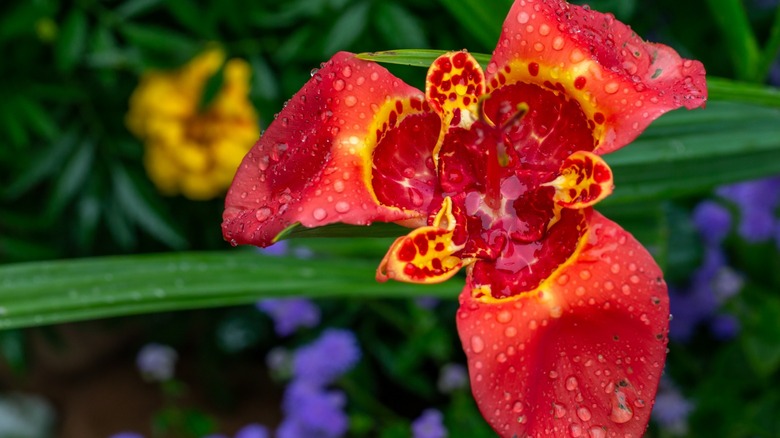The Beautiful Low-Maintenance Flower That'll Bring Vibrant Color To Your Garden
If you have a special appreciation for beautiful flowers, and you're looking for something unique to add to your garden, we've got just the thing! The tiger flower is also known as the Mexican shellflower, and formally as the tigridia. It is an exotic-looking variety that blooms throughout the summer and into early fall, making it the perfect choice for bringing vibrant color to your garden long after other varieties have stopped for the season.
You can choose from gorgeous shades of red, purple, pink, white, orange, and yellow, but what makes these blooms unique is their large, floppy-eared petals and two-toned speckled centers. There are more than 50 species, but they're not to be confused with the tiger lily.
They produce stunning blooms from about the middle of summer through September, and sometimes even into October, depending on where you live. They're easiest to propagate through their bulbs, as growing from seeds can take a couple of years to see a flower. Tiger flowers are low-maintenance, too, so if you're still working on that green thumb, why not give them a try?
Basic care of the tiger flower
Tiger flowers are extremely resistant to heat and humidity, being native to Mexico, and love full sun for optimal blooming results. The pH requirement of the soil is between 5.5 and 7.5, and loamy or sandy soil is ideal because it drains well. As for fertilization, use one with low nitrogen later in the spring but before blooming. As for watering, the soil should be kept moist as consistently as possible. Once established, you can back off quite a bit.
The blooms on tiger flowers only last a day, similar to the hibiscus flower. Once spent, clip the deadheads to help the plant save energy for new blooms instead of using it to create seed pods. Since these flowers grow from bulbs, the easiest way to propagate them is in this way, which we'll get into in more detail. If you live in a warmer climate, especially where the ground doesn't freeze often, they can survive the year round. Put about a 2-inch layer of mulch down if leaving them in the ground over winter.
Propagation and pruning of the tiger flower
Keep in mind that other than deadhead removal, tiger flower plants should not be pruned until they are clearly dead. It should be long after the flowers stop blooming and die, and the plant turns brown. This is because growth of the foliage after the season ends is necessary in order to rejuvenate the bulbs for the following year. As the individual flowers start to fade, cutting them back about 6 inches down the stalk will stimulate another round of blooms to enjoy.
Propagating the tiger flower is much like any other flower that grows from bulbs. In November or so, dig up your tiger flowers and examine the root structure. As you lift the bulbs, also called corms, from the dirt, remove any lingering stems or leaves. Carefully separate offset bulbs from the main "parent," taking each section and putting it into a small paper bag with about half a cup of sand in it. Discard the parent section, especially if it has sustained any kind of damage. Store paper bags together in a breathable fiber bag or sackcloth material, in a cool but dry place for the winter. Even if you want to stop propagating tiger flowers, continue to dig up the system about every three years, separating the bulbs to keep them healthy and vibrant.


